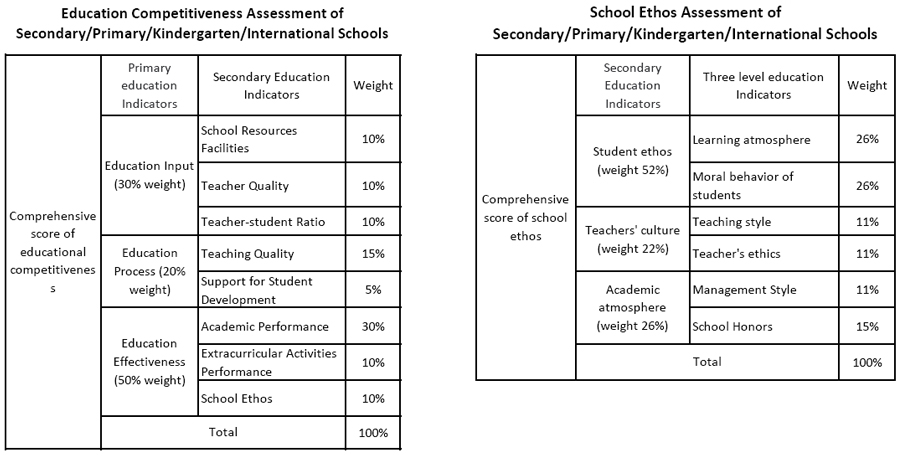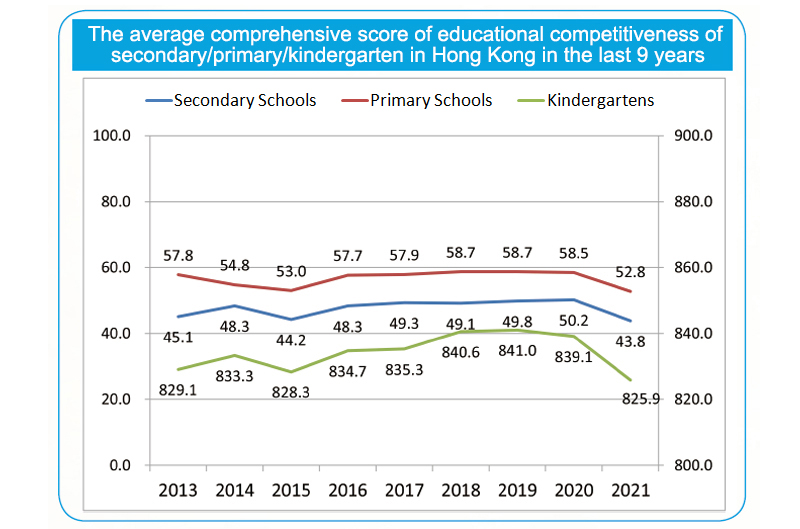編制本港中學/小學/幼稚園/國際學校教育競爭力排名指南系列書籍的目的在於提供有系統的資料,以顯示本港各學校教育成效,編篆方法如下:
1.從各個途徑搜集資料,編篆一套全面的本港學校競爭力評比的教育指標,範圍包括幼稚園至中學。2.選用聯合國教育、科學及文化組織一九九六年和一九九九年出版的統計年鑒有關國際通用的教育指標。
3.參考香港教育局二零零一年報告有關香港學校教育成效的教育指標,具體包括:教師質素,師生比率,教學質 素,學校資源及設施,學業成績,課外活動表現,學生支援措施,教師工作滿足感,過去三年教師平均流失率,教學語言,教學模式,學校歷史,過去五屆平均高考獲E級或以上百分率和人均優良率,過去五屆平均會考6科14分百分率、中英文合格率、人均優良率,過去五屆和應屆DSE文憑試成績(JUPAS入大學率、每年考入三大(港大/中大/科大)的學生人數及百分比、5**、5*、5級或以上優異率、4級或以上優良率及人均優良成績、33222大學入學標準百分率、3級和2級或以上合格率),小學升中學派位結果(升讀band 1、band 2 & band 3中學人數及比率),幼稚園升小學派位結果(升讀band 1、band 2 & band 3小學人數及比率),應屆IB課程成績(分別獲得IB45分/40分/35分以上的學生人數及百分比),每年考入世界排名前10/20/30/50/100大學的學生人數及百分比,中一入學前香港學科測驗成績,全港性系統評估成績(中三),學生參加學界校際及埠際體育比賽表現,學生參加學校音樂、戲劇、朗誦及舞蹈節表現,學生參加社會及志願服務表現,學習氣氛,學生品德行為,教學作風,教師師德,學校管理作風,學校榮譽等共63項2級和3級教育指標。
教育競爭力評比體系教育指標選取和概念說明
教育指標必須根據一些既定的準則去選取,教育競爭力排名指南採用的準則,有以下四項:
1. 指標應能提供充分的資料,及易為各層面的使用者理解,複合或複雜的指標應儘量避免採用。
2. 指標應能評估那些隨著時間而轉變的情況,以便進行有意義的比較,幫助決策者對日後的成效作出合理的預測。
3. 指標應能衡量學校教育成效中的持久特點,這有助聚焦未來的方向和需要。
4. 指標應能直接衡量或評估學校教育的成效,這些資料有助描述學校教育成效的目前運作情況和效能。
教育指標並不能把學校教育成效巨細無遺地顯示出來,它們只能就目前情況提供一些「簡括」的資料。由於每個指標只能提供一些單向的資料,因此有需要制訂一套指標,以便全面反映某一學校教育成效的情況。為了把整體情況顯示出來,有關的指標須合乎邏輯地連接在一起,而連接的方法應建立基於一個能說明學校教育成效運作情況的模式和架構。
至於制訂教育指標的概念模式或方法,有關的文獻數量不少。舉例說,Averch等(一九七一年)提出五個用來研究教育指標的方法:輸入輸出法、過程法、組織法、評估法及實驗法,Baker(一九七八年)提出教育指標的消費與生產模式,Yamamoto(一九八七年)倡議歸納法,Meuret(一九八七年)主張採用複合指標,等等。
中學/小學/幼稚園/國際學校教育競爭力評比體系
|
中學/小學/幼稚園/國際學校校風評比體系
|
||||||||||||||||||||||||||||||||||||||||||||||||||
| (有關2021/22中學/小學/幼稚園/國際學校教育競爭力評選指標體系及評比資料的處理方式和如何計算排名請參閱該書第三章詳細說明) | |||||||||||||||||||||||||||||||||||||||||||||||||||
至於制訂教育指標的概念模式或方法,有關的文獻數量不少。舉例說,Averch等(一九七一年)提出五個用來研究
教育指標的方法:輸入輸出法、過程法、組織法、評估法及實驗法,Ba k er(一九七八年)提出教育指標的消費與生產
模式,Yamamoto(一九八七年)倡議歸納法,Meuret(一九八七年)主張採用複合指標,等等。
在這項香港各中學/小學/幼稚園/國際學校教育競爭力評比中,我們採用了“教育投入—教育過程—教育成效”的架構,原因是它包括了本港教育學校運作的三個主要部分。此外,它亦符合上述四個準則的要求。我們因此把上述63項教育指標整合歸納為三層指標架構,三級教育指標不在這裡細述,如上圖乃此評比體系的一級教育指標和二級教育指標的描述。
學校教育競爭力評價在使內在的因素顯現化和指標化的過程中,不可避免地會損失部分資訊,一些內在的因素可能是難以顯現化和指標化的,而且,學校未來的生存和發展不僅受必然性的決定而且也受偶然性的影響,學校教育競爭力可能不是決定學校命運的唯一因素。因此,對學校教育競爭力的評價必然含有一定程度的不精確性和偶然性。我們的工作目標只能是盡可能地接近客觀真實,揭示其內在的屬性,但不可能十分精確地斷定學校教育競爭力的量值,更不可能以精確的量值來斷定具體學校的命運,就像對人體健康程度的評價不能精確地斷定具體個人的壽命一樣。但是,也正如對人體健康水凖的評價可以非常接近地反映人體的健康狀況和預期壽命一樣,對學校教育競爭力的評價也可以非常接近地反映學校教育競爭力的客觀狀況和預測學校未來的命運。
通過連續九年全港中學/小學/幼稚園教育競爭力評比,評比結果得到廣大家長的認同,為了更進一步幫助 家長們選校,我們今年增加了香港最具教育競爭力國際 學校20強榜單及HKPEP中國最具教育競爭力國際學校100 強榜單(包括大陸、香港、台灣、澳門兩岸四地)。
今年各中學/小學/幼稚園排名結果顯示受新冠疫情影響,學校停課導致本港中學/小學/幼稚園整體教育受 到衝擊,學生成績下降明顯(如下圖所示)。

就各組別而言,中學/小學組別依然由聖保羅男女 中學與拔萃女小學佔據榜首;幼稚園組別首度由國際英 文幼稚園稱雄;至於香港/中國國際學校組別,由德瑞國際學校力壓群雄摘冠。具體各中學/小學/幼稚園 /國際學校排名請看相關排名選校指南書籍。
中學/小學/幼稚園/國際學校教育競爭力評比的意義及運用價值
用數字說話,即用數字來反映香港各學校教育競爭力狀況。這是人們對競爭力分析和評價的一個普遍的期望,因為人們相信:數字勝於強辯,沒有數字就沒有說服力。
然而,數字是寶貴的,但數字也絕非萬能:數字是一種抽象,任何抽象都以一定程度的信息損失為代價;數字處理 必須以一定的假設條件為前提,而任何假設條件都以一定程度上的“忽視客觀具體”為代價;用數字進行判斷必須以一定的因果關係邏輯為基礎,而對因果關係邏輯的認識和判斷總是在一定程度上受主觀性的影響;在影響競爭力的各種因素中,有些是可以直接量化的,有的則難以直接量化,而只能採取某種間接量化方式(例如問卷調查),將其納入統計指標體系之中,這其中不可能不在一定程度上受主觀因素的影響。也就是說,任何有關競爭力的顯示性指標都不可能百 分之百地反映客觀。但是,只要遵循科學的原則,運用科學的方法,數字和數字分析卻可以無止境地“逼近”客觀,以數字所反映的各學校教育競爭力有可能成為各中學/小學/幼稚園/國際學校教育競爭力真實狀況十分逼真的影像。
數字的價值並非在於其本身,而在於對它的運用。我們要承認數字,尊重數字,但不盲目崇拜數字,在數字面前 喪失自己的判斷力。在我們所設計的監測指標體系中,其數據必須是可量化和可追溯。然而即使是最終的綜合得分, 也不是各學校教育綜合力排名的“風雲榜”,更不是對各學校教育競爭力大小強弱的判決,而只是競爭力監測的一個 “體檢表”。每一所學校都可以當其為一面鏡子,不妨看一看自己,也可以比一比別人。但不必依此而自傲或者因此 而自悲,也不必據此而張揚或者為此而抱怨。如果所有的學校特別是優秀學校,都能以豁達之心聽之,以借鑒之心視 之,以求真之心析之,以自審之心用之,那麼,我們這項中學/小學/幼稚園/國際學校教育競爭力監測工作就能實現其 最大的價值,開發出一個可持續有價值的各學校教育競爭力數字資源的共享寶庫,成為廣大家長們選校和教育工作者 的參考指南。
The Assessment series is designed to provide systematic information on the effectiveness of school education in Hong Kong. The script method is as follows:
1. Collect information from various sources to form all sorts of educational indicators in the Assessment.2. The educational indicators in the Assessment are selected from the internationally applicable sections of the Statistical Yearbook of the United Nations Educational, Scientific and Cultural Organization, published in 1996 and 1999.
3. Refer to the 63 Level 2 and Level 3 indicators in the 2001 report of the Hong Kong Education Bureau on the educational performance of Hong Kong schools, including teacher quality, teacher-student ratio and teaching quality, school resources and facilities, academic performance, extra-curricular performance, student support measures, teacher job satisfaction, average teacher attritions over the past three years, teaching language, teaching mode, school history, average percentage of E grade or above in the past five college entrance examinations and per capita excellent rate, average percentage of 14 points in 6 subjects in the past five HKCEE, qualified rate in Chinese and English, per capita excellent rate, results of the last five DSE Diplomas and the final year (the enrollment rate of JUPAS, the number and percentage of students admitted to HKU/CUHK/HKUST each year, 5**, 5*, 5 or above excellent rate, excellent rate of grade 4 or above and excellent results per capita,33222 percentage of university entrance criteria, pass rate of grade 3 and 2 or above), primary school to middle school allocation results (number and ratio of secondary schools in Band 1, Band 2 & Band 3), results of kindergarten placement into primary school (number and ratio of primary schools promoted to Band 1, Band 2 & Band 3), final IB course results (the number and percentage of students with IB45/40/35 or above respectively), the number and percentage of students admitted to the top 10/20/30/50/100 universities in the world each year, Hong Kong subject test results before entry to FORM 1, territory-wide System Assessment Results (Form 3), students' participation in inter-school and inter-port sports competitions, students participate in school music, drama, recitation and dance festivals, students' participation in social and voluntary services, learning atmosphere, students' moral behavior, teaching style, teachers' ethics, school management style, school honor, etc.
Indicators selection and concept description
It must be selected according to established criteria. Four specific criteria are as follows:
1. Provide sufficient evidence to be easily understood by users at all levels, and try to avoid using composite or complex indicators;
2. Withstand time and help decision-makers make reasonable predictions about future results;
3. Measure lasting characteristics in school education and help focus future direction;
4. Help describe the current operation and effectiveness of school education;
Educational indicators do not provide an exhaustive picture of the effectiveness of school education but only a "snapshot" of the current situation. Therefore, a set of indicators needs to be developed to give a comprehensive picture of the effectiveness of a particular school. The indicators need to be linked together logically in order to present the overall picture, and the linking method should be based on a model and framework that illustrates the overall functioning of school education.
There is considerable literature on conceptual models or methods for developing educational indicators. For example, Averch et al. (1971) proposed five methods for studying educational indicators: Input/output method, process method, organization method, evaluation method and experimental method, Baker (1978) proposed the consumption and production pattern of educational indicators, Yamamoto (1987) proposed induction method, Meuret (1987) advocated the use of composite indicators, and so on.
 |
| (Please refer to chapter 3 for details on the Assessment system, and how to process the evaluation data and calculate the ranking for 2021/22 secondary/primary/kindergarten/international school) |
The "Input - Process - Effectiveness" framework has been adopted in this Assessment as it covers the three main components of Hong Kong's education system. In addition, it also meets the requirements of the above four criteria. Therefore, the above 63 indicators are integrated into a three-tier structure, which is not described in detail here, and the description of the first and the second-level indicators is shown in the image above.
In the process of forming the Assessment, some information will inevitably be lost due to some internal factors, and the future survival and development of the school will be affected by contingency, so it may not be the only factor that determines the future of the school. Objective and factual data are provided as much as possible, but it is impossible to determine with great precision the future of specific schools, any more than assessments of human health can accurately determine individual longevity. However, just as the evaluation of the standard human health standard can very closely reflect the health and life expectancy of the human body, the Assessment can very closely reflect the objective condition and predict the future of the school.
The Assessment has been conducted for nine consecutive years, and the results have been recognized by the majority of parents. Rankings like Top 20 most competitive international Schools in Hong Kong and Top 100 International Schools with the most educational competitiveness in China were added this year in order to further help parents choose schools.
Due to the COVID-19 outbreak, school closures have impacted overall education in Hong Kong's secondary, primary and kindergarten schools, resulting in a significant drop in student performance (as shown in the chart below).

In terms of the secondary/primary division, St Paul's Girls' Secondary School and Diocesan Girls' Primary School still occupy the top spot; International English Kindergarten took the crown for the first time; DRE International School won the title in the Hong Kong/China International School category. Please see the relevant ranking guide for details.
The significance and value of the Assessment
There is a widespread expectation that numbers will reflect the state of Hong Kong's education as people believe that numbers speak louder than arguments. However, numbers are valuable but not omnipotent. Numbers are abstractions, at the cost of a certain amount of information loss; Digital processing must be based on certain assumptions, which are at the cost of "ignoring objective concreteness" to some extent. Judging by numbers must be based on certain logic of causality which is affected by subjectivity to some extent. The Assessment is also influenced by subjective factors. That is, it is impossible for any indicator of competitiveness to be 100% objective. As long as scientific principles and scientific methods are applied, numbers and numerical analysis can be infinitely close to objectivity and illustrate the educational situation in various schools by numbers.
The value of numbers lies in application. It should be recognize and respect numbers but don't idolize and lose judgment in front of them. The data must be quantifiable and traceable in the Assessment, however, the final score is not a judgment on the overall strength and weakness of each school. It will be its greatest value if all schools, especially excellent ones, can view the Assessment with an open-minded and self-examination attitude. It is hoped that it will become a repository of shared digital resources with sustainable value, providing a reference guide for parents choosing schools and educators.

